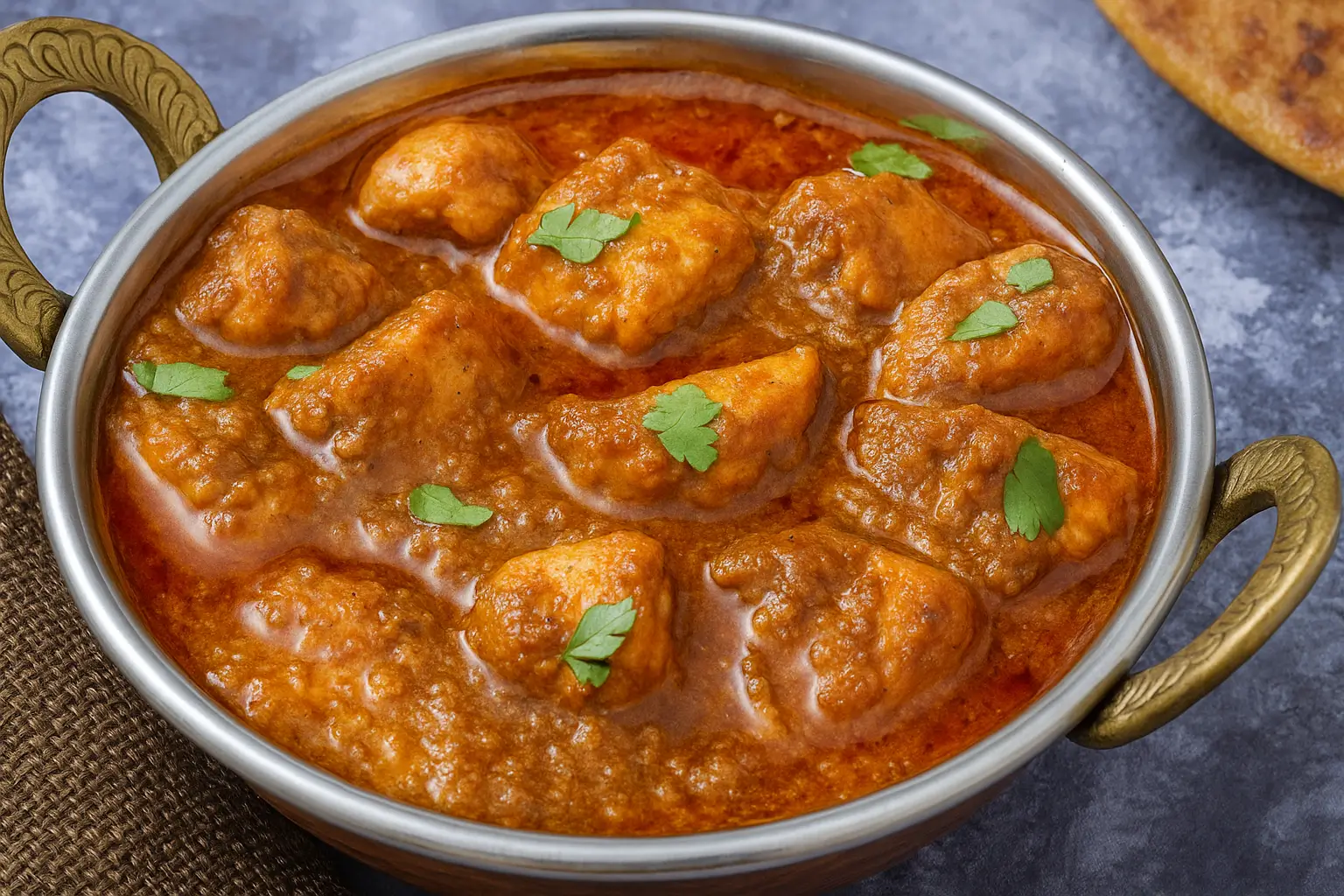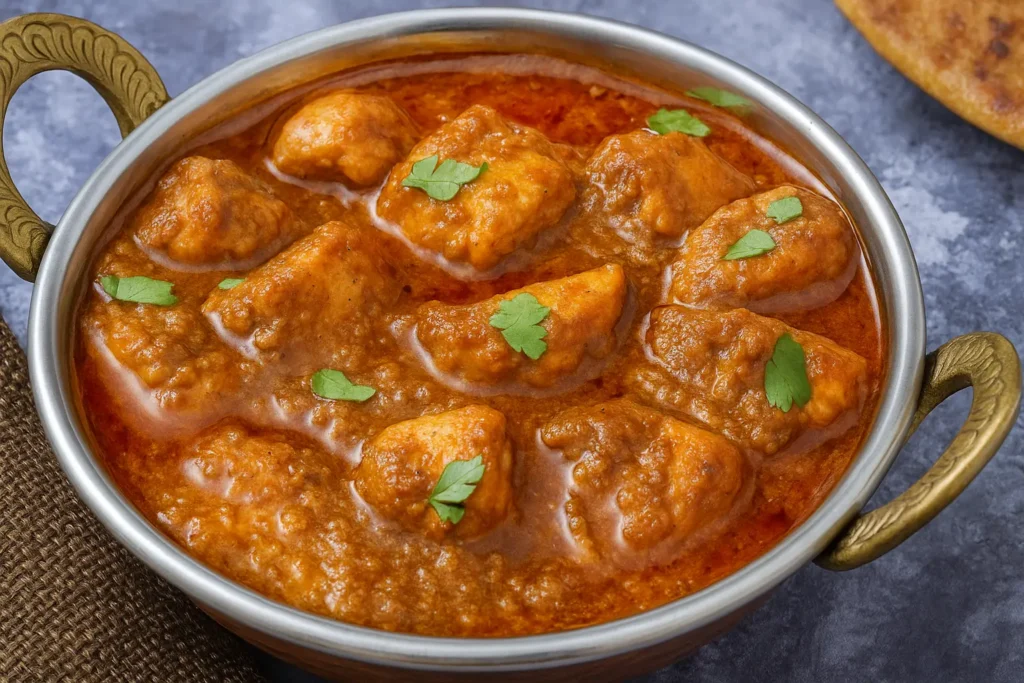
Why I Always Come Back to Chicken Korma
There’s a special kind of comfort that fills my heart whenever I cook chicken korma. It’s more than just a meal — it’s a piece of home. I still remember the very first time I tried making it. I had just graduated, was living away from family, and missing those familiar Eid mornings. So I called my mother and asked her for her chicken korma recipe, the same one she prepared during every celebration and family gathering. She patiently walked me through each step, making sure I understood how the chicken should simmer gently in the masala and how to balance the spices just right.
As I stirred the rich gravy and smelled the warm aroma of cardamom, cloves, and fried onions, it didn’t feel like I was just cooking — it felt like I was reconnecting with my roots. That moment turned this dish into something much more meaningful for me.
Now, chicken korma has become my trusted recipe whenever I want to serve something rich, traditional, and full of flavor. It’s one of those timeless chicken korma dishes that never fail to impress. In this guide, I’ll walk you through exactly how to make chicken korma just like my mother taught me — with clear instructions, helpful tips, easy variations, and common mistakes to avoid. Whether you’re a beginner or someone who enjoys classic korma recipes, you’re going to love how simple and satisfying this dish can be.
Table of Contents
What Is Chicken Korma?
Chicken korma is a rich and aromatic curry that traces its roots back to the royal kitchens of the Mughal Empire. Known for its elegant flavors and slow-cooked texture, it has become a beloved classic across India and Pakistan. Often served during special events like Eid, weddings, or family dinners, chicken korma holds a special place on the dining table.
What truly makes this korma recipe chicken stand out is its balanced taste — it’s neither overly spicy nor too mild. The gravy is built from a base of golden fried onions, thick curd, and a carefully layered blend of whole and ground spices. The result is a silky, flavorful sauce that clings beautifully to tender chicken pieces.
Over time, many regional versions of chicken korma dishes have developed, including the rich Shahi style and the bold Hyderabadi version. Even simple home-style kormas carry the same soul — a slow-simmered process that draws out deep flavor, aroma, and texture from every ingredient.
Ingredients for Chicken Korma (Serves 4)
This chicken korma recipe uses carefully chosen ingredients to deliver a rich, authentic flavor right from your home kitchen. For the best results, always opt for bone-in chicken and fresh whole spices — they create the deep, layered taste you’d expect from a traditional restaurant-style chicken korma.
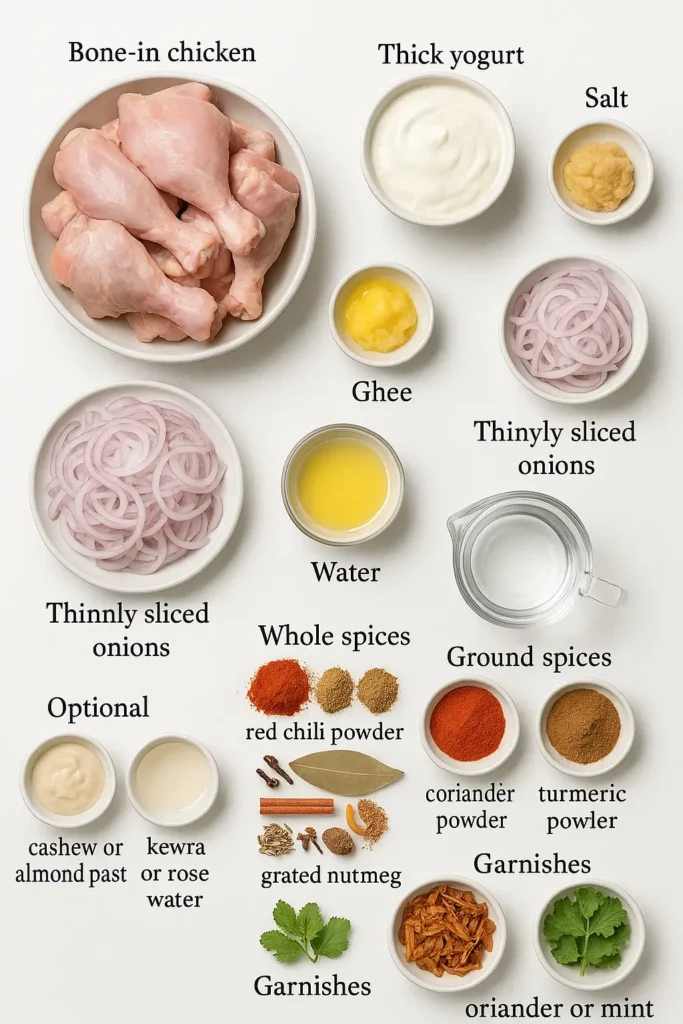
Chicken & Marinade
- 1 kg bone-in chicken, skin removed and cut into medium-sized pieces
- 1 cup thick yogurt, whisked until smooth
- 2 tablespoons ginger garlic paste
- Salt to taste
For the Base
- 2 medium onions, finely sliced
- ½ cup ghee or neutral oil (or a 50:50 combination of both for balanced richness)
- ¾ cup water (adjust during cooking as needed)
Whole Spices
- 4 green cardamoms
- 2 black cardamoms
- 6 cloves
- 1 small cinnamon stick (about 1 inch)
- 1 bay leaf
- ½ teaspoon cumin seeds
- A small piece of mace
- A pinch of grated nutmeg
Ground Spices
- 1 teaspoon red chili powder (adjust to your spice level)
- 1 teaspoon coriander powder
- ½ teaspoon turmeric powder
- ½ teaspoon garam masala (to finish)
Optional (For a Richer Version)
- 1 tablespoon cashew or almond paste
- 1 tablespoon kewra water or rose water (adds beautiful aroma)
Garnish
- Extra fried onions (for topping)
- Fresh chopped coriander or mint (optional, for a fresh finish)
Step-by-Step Guide: How to Make Chicken Korma the Traditional Way
One of the most frequent questions I receive is how to make chicken korma that tastes as rich and flavorful as the versions served at weddings or family celebrations. The answer lies not only in the ingredients but also in the timing and technique used during cooking. Follow these simple steps closely, and you’ll be enjoying a perfectly cooked, aromatic korma recipe chicken lovers truly admire.
Step 1: Fry the Onions
Heat ghee or oil in a heavy-bottomed pot over medium heat.
Add the thinly sliced onions and cook them slowly until they turn deep golden brown and crisp.
Once done, remove and place them on a paper towel to drain excess oil.
After they cool, crush or grind them coarsely.
Tip: Fried onions are the backbone of any great chicken korma recipe. Don’t rush this step. Under-browned or soggy onions will weaken the flavor of your gravy.
Step 2: Toast the Whole Spices
Using the same oil, add whole spices — cardamoms, cloves, cinnamon stick, bay leaf, cumin seeds, mace, and a pinch of grated nutmeg.
Let them sizzle for about 30 seconds to bring out their aroma.
Step 3: Add and Sear the Chicken
Add the chicken pieces to the pot and sear them over high heat.
Stir until they turn white on the outside and start to release their juices.
Add salt and continue to cook for 5 to 6 minutes.
Step 4: Stir in the Ginger-Garlic Paste
Lower the heat slightly and add the ginger garlic paste.
Sauté for 2 to 3 minutes until the raw smell disappears and the paste begins to brown slightly.
Step 5: Blend in the Ground Spices and Yogurt
Now add the ground spices: red chili powder, coriander powder, and turmeric.
Stir well and add a small splash of water to prevent the spices from sticking or burning.
Reduce the heat and slowly stir in the whisked yogurt.
Keep stirring as you pour to ensure a smooth, lump-free texture.
Tip: This slow mixing helps build the creamy texture that defines authentic korma recipe chicken fans recognize instantly.
Step 6: Add Fried Onions and Simmer
Mix in the crushed fried onions evenly.
Cover the pan and let the chicken simmer on low heat for 20 to 25 minutes, or until fully cooked and tender.
Stir occasionally and check the consistency. If it becomes too thick, add a few tablespoons of water to adjust the gravy.
Step 7: Add the Final Aromatics
Once the chicken is tender, add kewra water or rose water for a fragrant finish.
Sprinkle garam masala across the top and gently mix.
Turn off the heat and let the korma rest, covered, for 5 minutes before serving.
At this point, your chicken korma should have a silky, rich gravy with oil visibly separating along the sides — the signature sign of a well-made chicken korma dish.
Optional: For a Richer Version
For an even more luxurious texture, stir in a tablespoon of cashew or almond paste right before turning off the heat.
Many chicken korma dishes served at weddings and banquets use this extra step to boost richness and flavor.
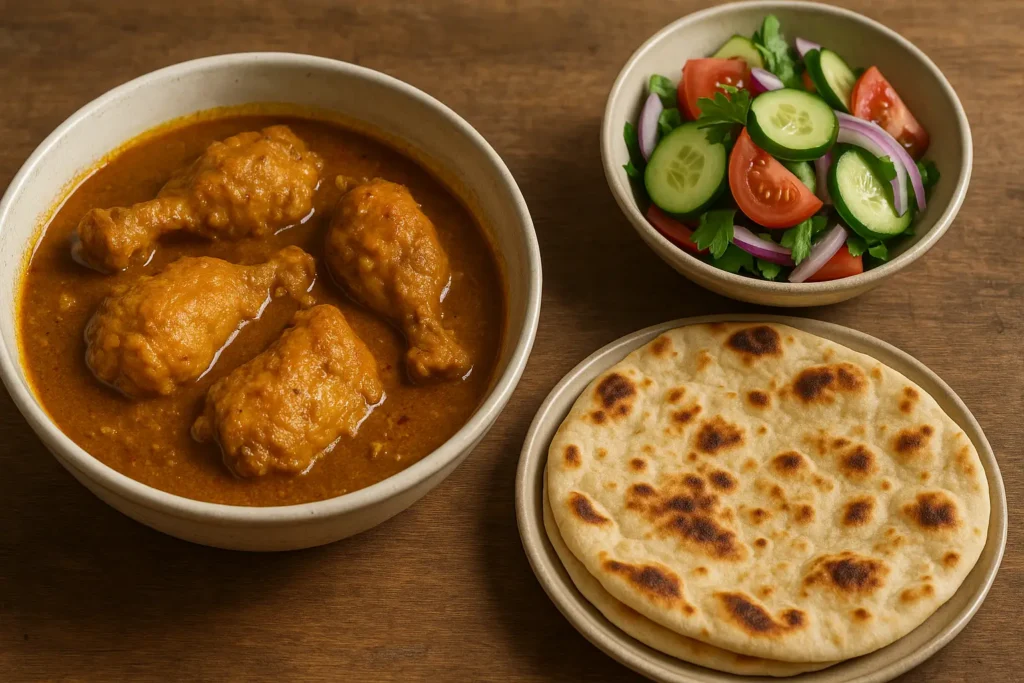
Expert Tips for Cooking the Best Chicken Korma
After preparing this dish many times in my own kitchen and tasting various chicken korma dishes in different cities, I’ve found that a few small techniques make a huge difference in achieving the perfect result. Whether you’re new to Indian cooking or looking to refine your korma recipe chicken method, these tried-and-true tips will help you cook like a pro.
1. Take Your Time with the Onions
One of the most important steps in making an authentic chicken korma recipe is frying the onions correctly. Don’t rush this part. The onions must be cooked slowly until they reach a deep golden brown. If they’re pale, the gravy will taste bland. If they’re burnt, the bitterness will ruin the entire dish. That deep color adds richness and depth to your korma’s base.
2. Always Use Bone-In Chicken
While boneless chicken is convenient, it lacks the depth of flavor that bone-in chicken brings. The bones help the meat stay juicy, and they release natural flavor into the gravy as the korma simmers. For truly flavorful chicken korma dishes, stick to bone-in cuts whenever possible.
3. Whisk the Yogurt Smoothly
Before adding yogurt to the gravy, whisk it until completely smooth. Then pour it in slowly while stirring, and make sure the flame is low. This prevents curdling — a mistake many beginners make. A creamy and lump-free texture is essential in every successful chicken korma recipe.
4. Let It Simmer Gently
Chicken korma is not a fast-cooked dish. Give it time to simmer slowly so that the flavors can fully develop and the chicken becomes melt-in-the-mouth tender. Rushed cooking leads to underwhelming flavor and texture. Real chicken korma dishes are made with patience.
5. Watch for Oil Separation
As your korma nears the end of cooking, you should see oil beginning to separate from the sides of the gravy. This is a key visual cue that your korma recipe chicken is ready and the flavors are fully cooked in. It’s a sign that your masala is done and your dish is rich, balanced, and aromatic.
Common Mistakes to Avoid
Making a traditional chicken korma recipe is not hard, but a few small errors can easily ruin the flavor or texture. Avoid these common mistakes to ensure your korma turns out rich, creamy, and perfectly balanced every time.
1. Leaving Out the Whole Spices
It might be tempting to skip the whole spices and just use ground versions, but that’s a big mistake. Whole spices are essential in building the complex flavor base of a proper chicken korma recipe. Toasting them in oil helps release their full aroma, creating the depth that defines this classic dish.
2. Adding Cold Yogurt to the Pan
Always bring the yogurt to room temperature before adding it to the gravy. Cold yogurt, especially straight from the fridge, will curdle as soon as it touches the hot oil or spices. To keep your korma smooth and creamy, whisk the yogurt well and add it slowly over low heat.
3. Using Too Much Water
One of the most common errors in making chicken korma dishes is adding excess water. A good korma recipe should have a thick, clingy gravy — not a watery or runny sauce. Add water gradually and only as needed during simmering. The gravy should coat the chicken pieces without becoming soupy.
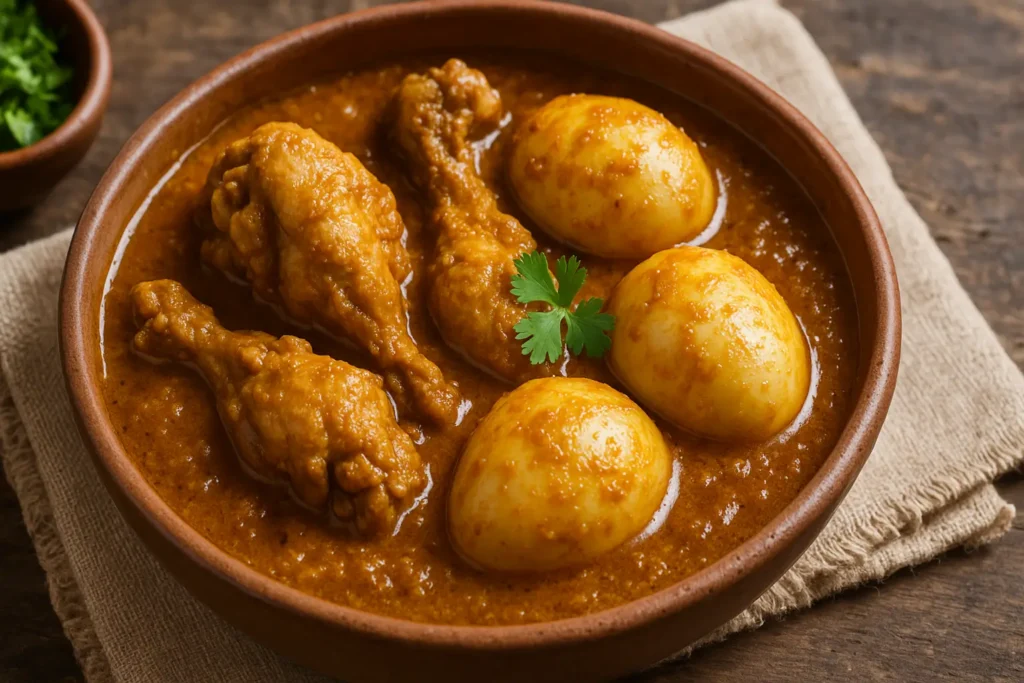
Delicious Variations
Different regions add their own twist to chicken korma. Here are three popular versions you can try:
1. Hyderabadi Chicken Korma
Includes poppy seeds and coconut, giving it a rich, nutty flavor with mild sweetness.
2. Shahi Chicken Korma
Made with cream, almond paste, and sometimes saffron. It’s rich, smooth, and perfect for special occasions.
3. Low-Fat Chicken Korma
Use less ghee, low-fat yogurt, and skip nuts. A lighter option without losing the classic korma taste.
How to Serve Chicken Korma Like a Pro
Serving chicken korma well means choosing sides that enhance its rich flavors. Whether for a casual dinner or a festive dawat, here are ideal pairings:
- Steamed Basmati Rice: A classic side that soaks up the korma’s creamy gravy and balances the spices.
- Roghni Naan or Sheermal: These soft breads make every bite more indulgent and are perfect for traditional meals.
- Boiled Eggs: Halved and placed on top before serving, they add richness just like in regional chicken korma dishes.
- Kachumber Salad: A mix of chopped cucumber, onion, and tomato with lemon juice adds freshness and cuts through the curry’s richness.
- Chapati or Paratha: Ideal for lighter meals, these are great options for weekday dinners.
Best occasions to serve this korma recipe chicken:
- Eid and festive gatherings
- Weekend family meals
- Weddings and traditional events
- Whenever you’re craving a classic comfort curry
Bonus Tip: Make It Ahead for Better Flavor
One of the best things about chicken korma is that it actually tastes better the next day. When the dish rests overnight in the fridge, the spices blend more deeply, and the gravy becomes richer and thicker. Just reheat it slowly on low heat before serving, and you’ll notice a deeper, more developed flavor than when it was freshly made. That’s why many home cooks and chefs prefer making this korma recipe chicken a day in advance, especially for guests or festive occasions.
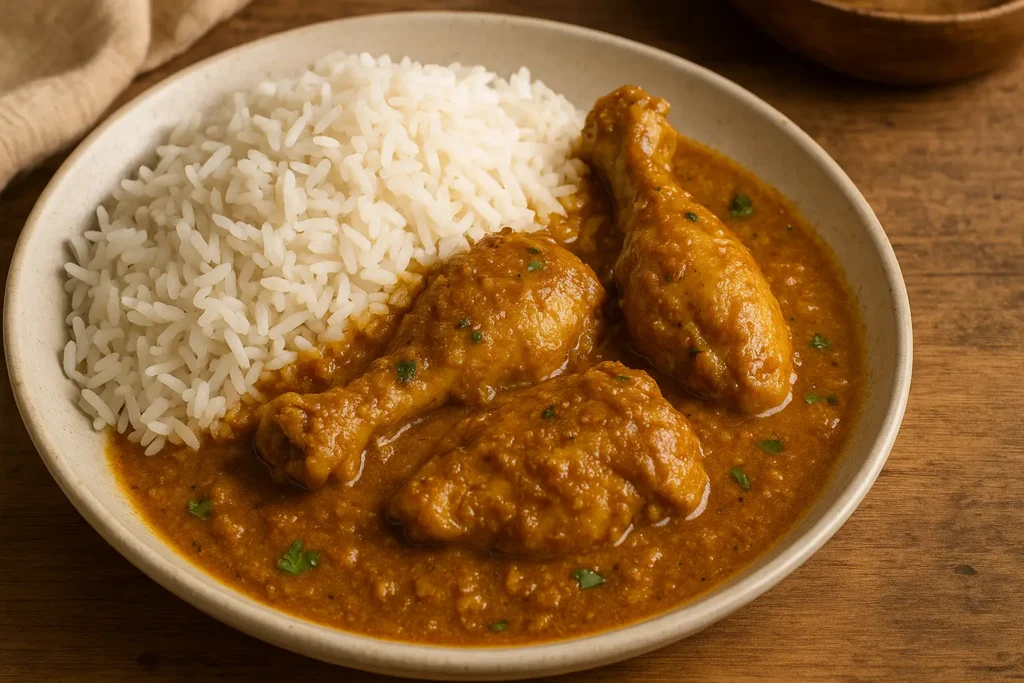
Frequently Asked Questions (FAQs)
Q1: What makes this chicken korma different from other chicken curries?
The secret lies in the method. Unlike tomato-based curries, chicken korma dishes use yogurt and fried onions to create a thick, luxurious gravy that’s rich in aroma and taste — not just heat.
Q2: Can I make chicken korma without nuts or cream?
Absolutely. The classic chicken korma recipe doesn’t require cream or nut pastes. They’re optional for extra richness, but the base of fried onions and yogurt is what gives the korma its signature taste.
Q3: How do I fix a watery korma?
If your korma recipe ends up too thin, simply increase the flame and reduce it uncovered until it thickens. Adding extra fried onions can also help to restore body to the gravy.
Q4: Is chicken korma spicy?
Not by default. Most chicken korma dishes are aromatic, not fiery. You can adjust the heat to your preference by modifying the amount of red chili powder or adding green chilies if desired.
Final Thoughts
This recipe isn’t just another dish in your collection — it’s a story passed down through generations, rich in tradition and packed with heart. From the carefully browned onions to the slow-cooked spices that melt into the chicken, every detail matters. It’s a recipe built on patience, precision, and love.
Whether you’re exploring how to make chicken korma for the very first time or revisiting it after years, this method delivers reliability, richness, and a deeply satisfying taste that brings people together at the table. And if you’re looking to explore more classic dishes, don’t miss this flavorful Keema Paratha Recipe that pairs beautifully with creamy gravies like korma. If you liked this recipe, do let me know in the comments below and don’t forget to share it.

